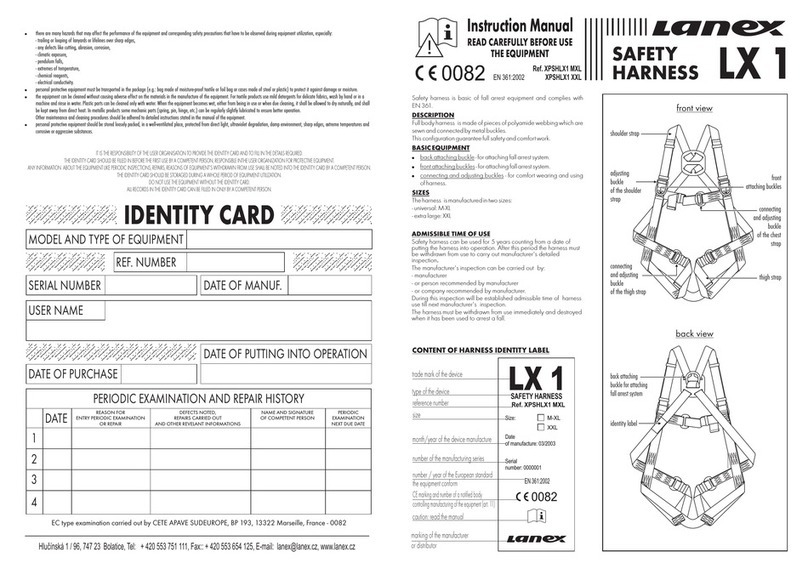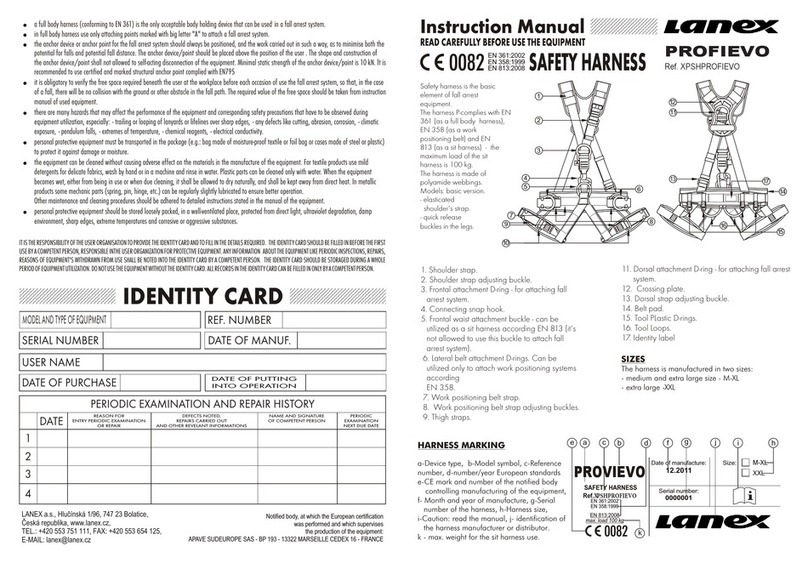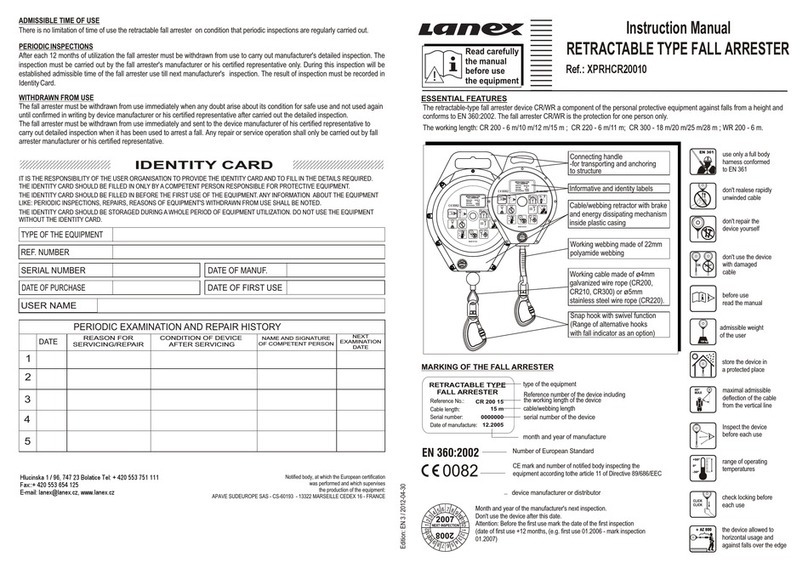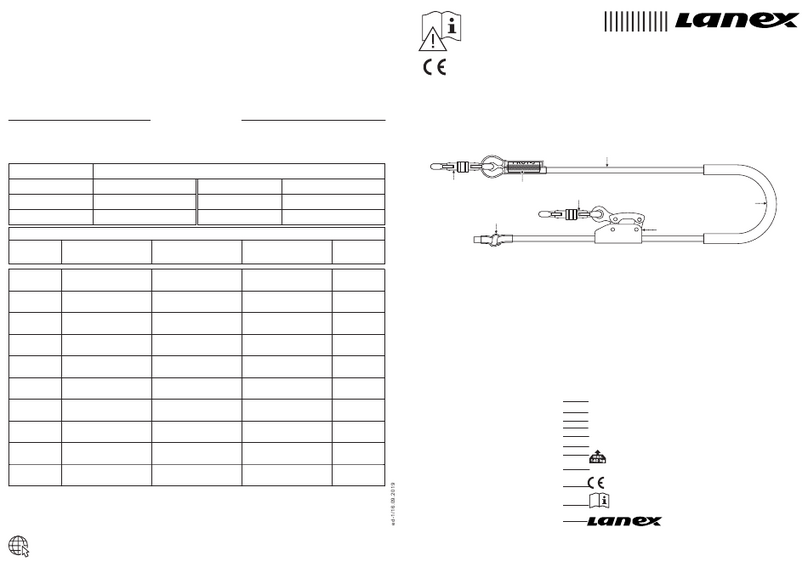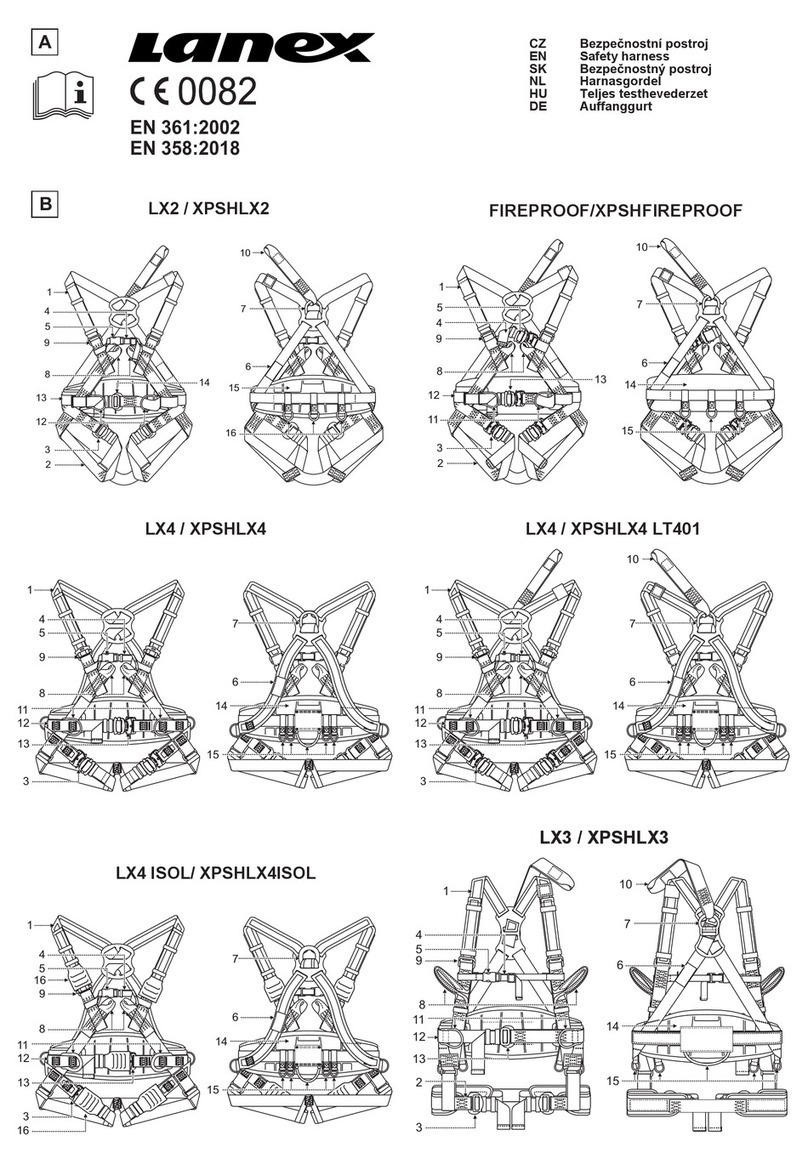
CorrectCorrect IncorrectIncorrect IncorrectIncorrect
!personal protective equipment shall only be used by a person trained and competent in its safe use.
!personal protective equipment must not be used by a person with medical condition that could affect the safety of the equipment user in normal and emergency use.
!a rescue plan shall be in place to deal with any emergencies that could arise during the work.
!it is forbidden to make any alterations or additions to the equipment without the manufacturer's prior written consent.
!any repair shall only be carried out by equipment manufacturer or his certified representative.
!personal protective equipment shall not be used outside its limitations, or for any purpose other than that for which it is intended.
!personal protective equipment should be a personal issue item.
!before use ensure about the compatibility of items of equipment assembled into a fall arrest system. Periodically check connecting and adjusting of the equipment
components to avoid accidental loosening or disconnecting of the components.
!it is forbidden to use combinations of items of equipment in which the safe function of any one item is affected by or interferes with the safe function of another.
!before each use of personal protective equipment it is obligatory to carry out a pre-use check of the equipment, to ensure that it is in a serviceable condition and operates
correctly before it is used.
!during pre-use check it is necessary to inspect all elements of the equipment in respect of any damages, excessive wear, corrosion, abrasion, cutting or incorrect acting,
especially take into consideration:
- in full body harnesses and belts - buckles, adjusting elements, attaching points, webbings, seams, loops;
- in energy absorbers - attaching loops, webbing, seams, casing, connectors;
- in textile lanyards or lifelines or guidelines - rope, loops, thimbles, connectors, adjusting element, splices;
- in steel lanyards or lifelines or guidelines - cable, wires, clips, ferrules, loops, thimbles, connectors, adjusting elements;
- in retractable fall arresters - cable or webbing, retractor and brake proper acting, casing, energy absorber, connector;
- in guided type fall arresters - body of the fall arrester, sliding function, locking gear acting, rivets and screws, connector, energy absorber;
- in connectors - main body, rivets, gate, locking gear acting.
!after every12 months of utilization, personal protective equipment must be withdrawn from use to carry out periodical detailed inspection. The periodic inspection must be
carried out by
a competent person for periodic inspection. The periodic inspection can be carried out also by the manufacturer or his authorized representative.
In case of some types of the complex equipment e.g. some types of retractable fall arresters the annual inspection can be carried out only by the manufacturer or his
authorized representative.
!regular periodic inspections are the essential for equipment maintenance and the safety of the users which depends upon the continued efficiency and durability of the
equipment.
!during periodic inspection it is necessary to check the legibility of the equipment marking.
!it is essential for the safety of the user that if the product is re-sold outside the original country of destination the reseller shall provide instructions for use, for
maintenance, for periodic examination and for repair in language of the country in which the product is to be used.
!personal protective equipment must be withdrawn from use immediately when any doubt arise about its condition for safe use and not used again until confirmed in
writing by equipment manufacturer or his representative after carried out the detailed inspection.
!personal protective equipment must be withdrawn from use immediately and destroyed when it have been used to arrest a fall.
,
!a full body harness complied with EN 361 is the only acceptable body holding device that can be used in a fall arrest system.
!the anchor device or anchor point for the fall arrest system should always be positioned, and the work carried out in such a way, as to minimize both the potential for falls
and potential fall distance. The anchor device/point should be placed above the position of the user . The shape and construction of the anchor device/point shall not
allowed to self-acting disconnection of the equipment. Minimal static strength of the anchor device/point is 10 kN. It is recommended to use certified and marked structural
anchor point complied with EN795.
THE ESSENTIAL PRINCIPLES FOR USERS OF PERSONAL PROTECTIVE EQUIPMENT
INSTALLATION OF THE DEVICE
1. Connect snap hook of the rope adjuster to the right attaching buckle of the work positioning belt (or left for left-handed employee)-
drawing 1.
2. Put the rope around the construction element and connect rope snap hook to the left attaching buckle of the work positioning belt (or
right for left handed employee) - drawing 2.
or
3. Connect the rope snap hook to the anchor point situated above the waist level - drawing 3.
4. Using the rope adjuster, adjust the length and the tension of the rope to assure a stable work position and restrict the free fall of the
worker. The distance of the free fall should not exceed 0,5 m. - drawing 4.
A. Lengthening the rope (4A):
,catch the rope with the left (right) hand in point between the rope adjuster and the
construction;
,lightly stretch the rope by controlled deflection of the body till the rope is lengthening;
,squeeze the adjuster lever with the right (left) hand;
,releasing the lever will stops moving the rope inside the adjuster.
B. Shortening the rope (4B):
,keep the rope adjuster with the left (right) hand and pull the free ending of the rope,
with the right (left) hand, in the back direction, inclining the body in the direction of the
construction either;
ATTENTION - Inside the brackets: there are sides that the left-handed employee should use.
NECESSARILY PROTECT
THE SNAP HOOK GATE
WITH THE LOCKING GEAR
1
4
2
4A
4B
!using the work positioning device PROT-40 in connection with fall arrest system must be compatibile with use instructions of the fall
arrest systems and obligatory standards:
- EN 361 - for safety harness
- EN 358 - for work positioning belts
- EN 354, EN 355, EN 353-1, EN 353-2, EN 360, EN 362 - for the fall arrest systems.
3
IT IS FORBIDDEN TO USE THE WORK POSITIONING DEVICE PROT-11 FOR APPLICATIONS
OTHER THAN THOSE SPECIFIED IN THE INSTRUCTION MANUAL
!work positioning device PROT-40 is not the fall protection and it should not be used as the protection against the fall from a height.
The independent fall arrest system must be used to protect the worker duringthe work at the height.

